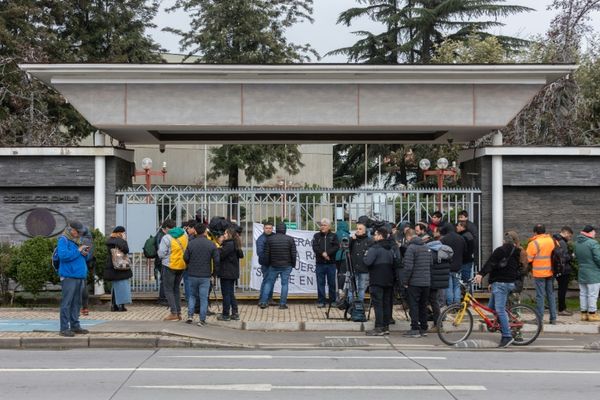Stocks closed off a tumultuous year on a sour note in December, with major indexes posting their worst losses since 2008. Many of the best mutual funds and ETFs ended December in the red, though a few categories came out well ahead on the year.
The 10-year U.S. Treasury yield finished 2022 at 3.88%. That's 20 basis points higher than at the end of November, and over 2%, or 200 basis points, higher than at the start of the year. The yield curve, which tracks yields for various bond maturities, ended the year inverted. This usually signals a looming recession.
U.S. diversified equity funds sank an average of 5.12% in December, for a total loss of 17.45% in 2022, according to Refinitiv Lipper data. Meanwhile, the S&P 500, the Dow and the Nasdaq fell 5.76%, 4.17% and 8.67%, respectively, in December. However, for the fourth quarter, the major averages were each up 7.56%, 15.39%, and down 0.79%. For the year, they're down 18.11%, 8.78% and 32.54%, respectively. Bonds had one of the worst years as well as rates rose.
Despite the lackluster performance, financial experts predict things could get worse before they get better in 2023.
"There's still a debate about whether there'll technically be a recession in 2023," said Richard Weiss, senior vice president and chief investment officer of multi-asset strategies at American Century Investments.
"But whether or not we actually hit two quarters of negative real growth or not, or whether the economy actually stalls or just crawls, I think the argument is moot. There's now question we're going to come close enough to a recession to be harmful."
Gearing Up For Higher Rates
In the U.S. diversified equity fund space, riskier funds fared the worst in the month and the year. Those that lost the most include equity leverage and growth funds across all sizes of stocks. Within sectors, only commodities base metals, precious metals and agriculture funds ended the month in the green. For the year, commodities energy and natural resources funds stole the spotlight. World equity funds shed an average of 2.5% in December and 19.58% on the year.
Bonds didn't do much better. General domestic taxable fixed-income funds fell 0.46% in December for a yearly loss of 9.06%. General U.S. Treasury funds sank 1.21% and 20.59%, respectively. Emerging markets local and hard-currency debt funds fared a bit better, picking up over 1% in December and 8% in the fourth quarter. However, they were still down over 10% in 2022.
"The low interest-rate era is over and there are a lot of central banks that are quite aggressive in their monetary policy," said Matthew Bartolini, managing director and head of SPDR Americas Research at State Street Global Advisors. "There's a double bear market. There's never been a time period where both stocks and bonds had been in a bear market at the same time."
He said that investors hoped that the Federal Reserve would be less aggressive in December. But the reality set in that the Fed remains focused on inflation, which remains stubbornly high.
Looking For Best ETFs
In the ETF world, few funds showed positive returns in December. Among the best U.S. diversified ETFs were Simplify Volatility Premium, up 1.6%, and Pacer Trendpilot US Large Cap, up 0.27%. For the year, dividend ETFs were the top performers. Those include WisdomTree US High Dividend, Invesco S&P Ultra Dividend Revenue and iShares Core High Dividend — all up over 7%.
Sector funds had a tough month and year. Nearly every sector was down in December. Gold rallied, however, with Sprott Gold Miners and iShares MSCI Global Gold Miners returning around 2%. The metal and the funds are still down on the year.
Other sector ETFs with positive performance in December were SPDR S&P Oil & Gas Equipment Services, iShares US Oil Equipment & Services and VanEck Pharmaceutical, up over 1%. Oil & gas was the best sector in 2022. Energy prices were pushed up by the war in Ukraine and supply constraints. The best energy ETFs returned over 60% in 2022.
Overseas Opportunities For Best ETFs
Internationally, several emerging markets continued to do well. IShares MSCI Turkey, iShares MSCI Chile an iShares MSCI Brazil surged 106%, 25% and 12%, respectively, last year. December was also a good month for several countries, including China.
A major contributor was "the reopening of the China economy — the loosening of the Covid-zero policies," said Mark Carlson, senior investment strategist of FlexShares ETFs at Northern Trust Asset Management. He said that in the near term, the staggeringly high infection levels will impact production levels and transportation, which in turn might diminish demand for raw materials. This could place a damper on the goods portion of U.S. inflation.
More volatility could be in store for the markets until they find a bottom.
"The stock market in the last few weeks is finally waking up to the fact that there's going to be a slowdown," said Weiss. "Equity markets have been myopically focused on an early pivot of the Fed and hopes for a soft landing, but many market participants have been ignoring the fact that we are going to hit a downturn here, and it's going to affect earnings. Meanwhile, you've got interest rates rising. This is a perfect storm for a bear market."
Eyeing 2023
That said, he believes 2023 might have a few good surprises in store.
"I think there's a great case to make for a much better outlook this year than this past year," Weiss said. "I think 2023 may actually wind up being the polar opposite of 2022. But there might be some more pain to come before that. Equity markets are still pretty lofty in terms of valuations."
As such, he's underweight domestic equities and prefers ex-U.S. stock markets on a relative basis. These are slightly ahead on the economic cycle vs. the U.S. He's also overweight defensive, value sectors vs. the market. On the fixed-income front, he favors quality such as U.S. Treasury and government bonds. FlexShares' Carlson still likes high yield bonds due to their lower interest-rate sensitivity.
He says that "right now the high-yield market is a fully functioning, liquid, deep source of capital for those companies that choose to structure their balance sheets accordingly. It's not like the old days." There are some technical elements that are in favor for the high-yield universe, he said. "Defaults remain low, credit quality remains high and there's still some time frame before we start seeing a significant amount of maturities."
Picking Potential Best ETFs
FlexShares High Yield Value-Scored Bond Index has an SEC yield of 10%.
While many trends from 2022 will continue into 2023, SSGA's Bartolini believes "At some point (there) will be a pivot associated with all of this. There will be an inflection point in that the market will find some form of a bottom, both on their earnings perspective, but also on the monetary policy perspective."
As such, he recommends striking a balance between offense and defense. Dividend-paying equities are a good example. Those firms are usually profitable, have a cyclical bias and have also done quite well in 2022.
SPDR Portfolio S&P 500 High Dividend was down only 1.14% in 2022 and represents a the offense-defense balance Bartolini is referring to. The $7.5 billion fund only charges 0.07% in annual fees.







